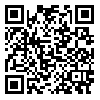Wed, Apr 24, 2024
[Archive]
Volume 5, Issue 2 (May 2020)
JNFS 2020, 5(2): 93-96 |
Back to browse issues page
Download citation:
BibTeX | RIS | EndNote | Medlars | ProCite | Reference Manager | RefWorks
Send citation to:



BibTeX | RIS | EndNote | Medlars | ProCite | Reference Manager | RefWorks
Send citation to:
Khayyatzadeh S S. Nutrition and Infection with COVID-19. JNFS 2020; 5 (2) :93-96
URL: http://jnfs.ssu.ac.ir/article-1-310-en.html
URL: http://jnfs.ssu.ac.ir/article-1-310-en.html
Nutrition and Food Security Research Center, Shahid Sadoughi University of Medical Sciences, Yazd, Iran.
Abstract: (2944 Views)
No abstract
Keywords: COVID-19
Type of article: editorial article |
Subject:
public specific
Received: 2020/03/10 | Published: 2020/05/1 | ePublished: 2020/05/1
Received: 2020/03/10 | Published: 2020/05/1 | ePublished: 2020/05/1
References
1. Arthur JR, McKenzie RC & Beckett GJ 2003. Selenium in the immune system. Journal of nutrition. 133 (5): 1457S-1459S.
2. Asdamongkol N, Phanachet P & Sungkanuparph S 2013. Low plasma zinc levels and immunological responses to zinc supplementation in HIV-infected patients with immunological discordance after antiretroviral therapy. Japanese journal of infectious diseases. 66 (6): 469-474.
3. Atherton J, Kratzing C & Fisher A 1978. The effect of ascorbic acid on infection of chick-embryo ciliated tracheal organ cultures by coronavirus. Archives of virology. 56 (3): 195-199.
4. Baum MK, Lai S, Sales S, Page JB & Campa A 2010. Randomized, controlled clinical trial of zinc supplementation to prevent immunological failure in HIV-infected adults. Clinical infectious diseases. 50 (12): 1653-1660.
5. Beck MA 2007. Selenium and vitamin E status: impact on viral pathogenicity. Journal of nutrition. 137 (5): 1338-1340.
6. Calder P 1998. Immunoregulatory and anti-inflammatory effects of n-3 polyunsaturated fatty acids. Brazilian journal of medical and biological research. 31 (4): 467-490.
7. Castaño PM, Andres R, Lara M & Westhoff C 2006. Assessing feasibility of text messaging to improve medication adherence. Obstetrics & Gynecology. 107 (4): 40S.
8. Chambial S, Dwivedi S, Shukla KK, John PJ & Sharma P 2013. Vitamin C in disease prevention and cure: an overview. Indian journal of clinical biochemistry. 28 (4): 314-328.
9. Clark WF & Parbtani A 1994. Omega-3 fatty acid supplementation in clinical and experimental lupus nephritis. American journal of kidney diseases. 23 (5): 644-647.
10. Das U 1994. Beneficial effect of eicosapentaenoic and docosahexaenoic acids in the management of systemic lupus erythematosus and its relationship to the cytokine network. Prostaglandins, leukotrienes and essential fatty acids. 51 (3): 207-213.
11. Field CJ, Johnson IR & Schley PD 2002. Nutrients and their role in host resistance to infection. Journal of leukocyte biology. 71 (1): 16-32.
12. Guan W-j, et al. 2020. Clinical characteristics of coronavirus disease 2019 in China. New England journal of medicine.
13. Gwin JA, et al. 2019. Higher protein density diets are associated with greater diet quality and micronutrient intake in healthy young adults. Frontiers in nutrition. 6.
14. Hemilä H & Douglas RM 1999. Vitamin C and acute respiratory infections. International journal of tuberculosis and lung disease. 3 (9): 756-761.
15. Jee J, et al. 2013. Effects of dietary vitamin A content on antibody responses of feedlot calves inoculated intramuscularly with an inactivated bovine coronavirus vaccine. American journal of veterinary research. 74 (10): 1353-1362.
16. Kańtoch M, Litwińska B, Szkoda M & Siennicka J 2002. Importance of vitamin A deficiency in pathology and immunology of viral infections. Roczniki panstwowego zakladu higieny. 53 (4): 385-392.
17. Prasad AS, Fitzgerald JT, Bao B, Beck FW & Chandrasekar PH 2000. Duration of symptoms and plasma cytokine levels in patients with the common cold treated with zinc acetate: a randomized, double-blind, placebo-controlled trial. Annals of internal medicine. 133 (4): 245-252.
18. Read SA, Obeid S, Ahlenstiel C & Ahlenstiel G 2019. The role of zinc in antiviral immunity. Advances in nutrition. 10 (4): 696-710.
19. Schwerbrock NM, Karlsson EA, Shi Q, Sheridan PA & Beck MA 2009. Fish oil-fed mice have impaired resistance to influenza infection. Journal of nutrition. 139 (8): 1588-1594.
20. Solomons NW 2001. Dietary sources of zinc and factors affecting its bioavailability. Food and nutrition bulletin. 22 (2): 138-154.
21. Supúlveda RT, Zhang J & Watson RR 2002. Selenium supplementation decreases coxsackievirus heart disease during murine AIDS. Cardiovascular toxicology. 2 (1): 53-61.
22. Tantcheva L, et al. 2003. Effect of vitamin E and vitamin C combination on experimental influenza virus infection. Methods and findings in experimental and clinical pharmacology. 25 (4): 259-264.
23. Woodward B 1998. Protein, calories, and immune defenses. Nutrition reviews. 56 (1): S84-S92.
24. World Health Organization 2009. Global prevalence of vitamin A deficiency in populations at risk 1995-2005: WHO global database on vitamin A deficiency.
Send email to the article author
| Rights and permissions | |
 |
This work is licensed under a Creative Commons Attribution-NonCommercial 4.0 International License. |







